Home » General Knowledge » 7 Wonders of India – Architectural Marvels and Cultural Treasures
7 Wonders of India - Architectural Marvels and Cultural Treasures
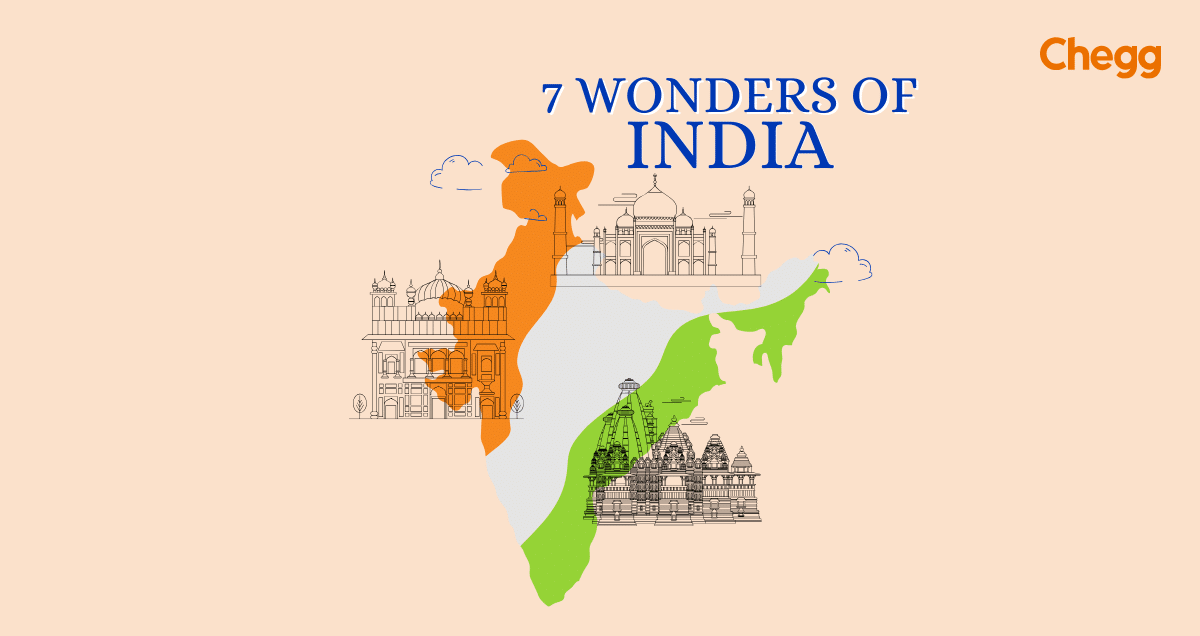
Table of Contents
India is a country with a huge range of diversity in culture and way of living. A myriad of civilizations and dynasties have marked the history of India. The 7 wonders of India signify this diversity. They are symbols of the creativity and innovation our ancestors had expressed through magnificent landmarks.
People defined the 7 wonders of India to celebrate these landmarks and ensure their protection for future generations. Their importance in signifying the architectural growth of India is paramount, but they also function as a gateway to the culture and heritage of India.
India’s rich history has provided the generation with grand palaces and remarkable temples, mosques, and other holy places. Their grandeur shows intricate craftsmanship and immaculate architectural planning. They show us how our ancestors used to live and their beliefs. Their cultural practices, and more.
7 Wonders of India: Historical and Cultural Significance
Each monument listed as one of the 7 wonders of India has its significance in history. People consider a country’s culture to be the building block upon which its development is based. This culture actively expresses itself through various means, including values, practices, shared beliefs, monuments, and so on.
The 7 wonders of India, chosen to represent the country’s rich heritage, highlight the multifaceted culture that has flourished in India. They are a reservoir of knowledge regarding India’s history, artistry, and heritage.
In India, monuments and wonders found in different regions will show you different types of architecture and culture. The variety shows how India has been home to several civilizations and cultures. For example, Dravidian architecture dominates most ancient monuments, temples, and buildings in the southern parts of the country. On the other hand, North India sports some of the most famous wonders of Indo-Islamic architecture.
How Many Wonders in India?
As listed by UNESCO, India has one of the highest number of World Heritage Sites. Out of these Heritage Sites, the Ministry of Culture has picked 7 sites as the 7 wonders of India. Each site signifies a specific period of Indian history and showcases that time’s beliefs, architecture, and culture.
The criteria through which these 7 wonders of India are picked are as follows:
- Humans should build all the structures, monuments, and buildings in an acceptable state of preservation. They should be reconstructed without visual aids and perceived directly, without artificial help.
- The monuments and structures should have profound architectural or artistic value in human history.
- The buildings and monuments should be universally recognized. They should be only in the world, with no replicas present worldwide.
- The buildings selected should be such that they should signify the cultural and social diversity of the people and ancestors.
Seven Wonders of the India with Names
How many wonders in India are currently present? This list presents seven wonders of India, chosen based on their historical significance.
1. Gomateshwara- Karnataka
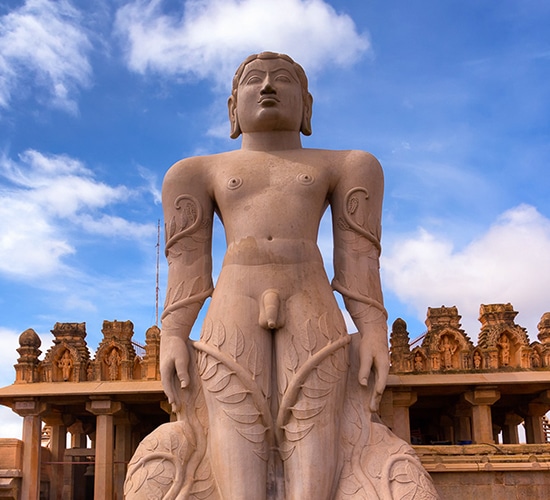
Gomateshwara Statue, also called the Bahubali Temple, dates back to 983 AD. Located in the village of Shravanabelagola, India’s largest monolithic statue. Sculptors carved the statue from a single block of granite. It stands 57 feet tall and is visible from at least 30 kilometers away, situated above the Vidhyagiri hill of the village. Gomateshwara is an essential figure in the history of Jainism, being the second son of the first Tirthankara of Jains.
Voted as one of the seven wonders of the India in 2007, the statue symbolizes non-violence and provides peace and relief for people.
2. Hampi- Karnataka
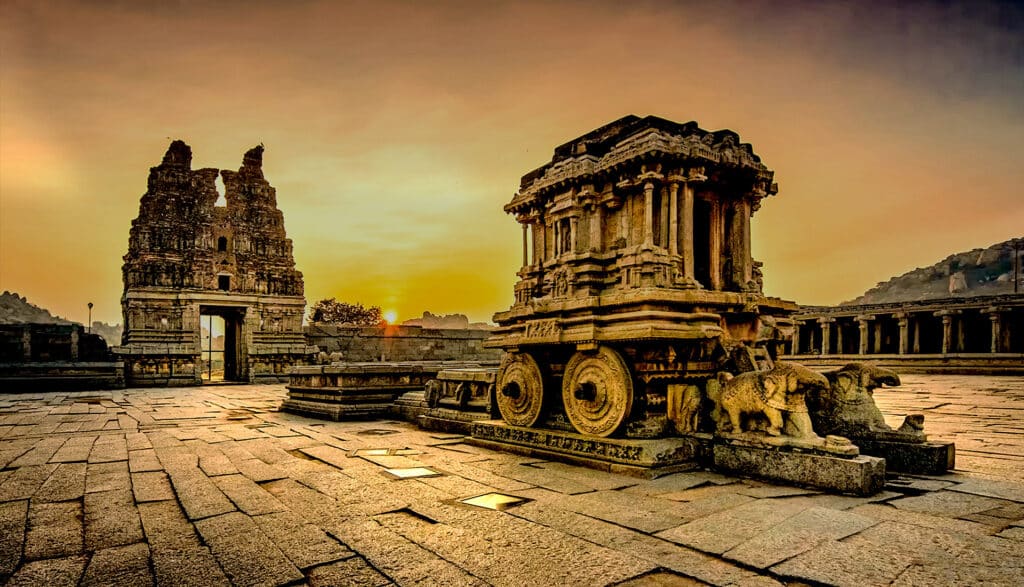
Hampi was the capital of the majestic Vijayanagara Empire, the last great Hindu Kingdom. Spread over 4187 hectares, the city’s ruins are located in modern India’s Bellary district of Karnataka, by the Tungabhadra basin.
The most prominent structures remaining are the Krishna Temple Complex, Achyutaraya Temple Complex, Vitthala Temple Complex, Lotus Mehal Complex, Pattabhirama Temple Complex, etc.
3. Harmandir Sahib Golden Temple- Punjab
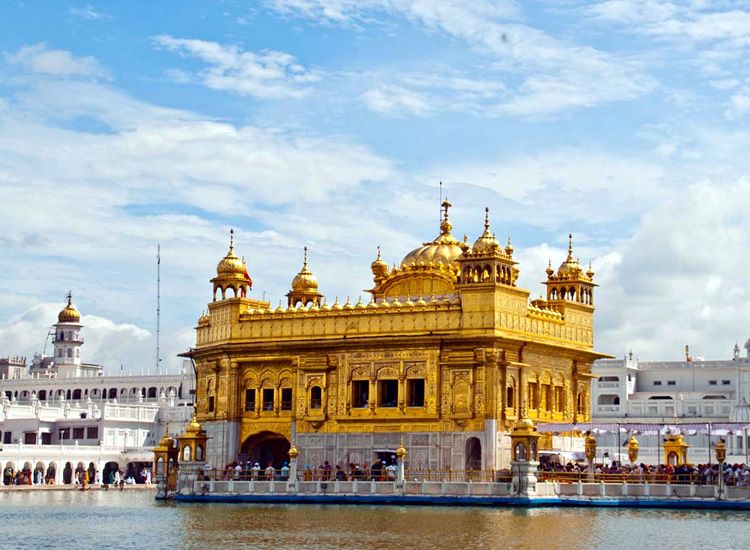
Harmandir Sahib, more commonly known as the Golden Temple or Darbar Sahib, is the chief gurdwara for Sikhs, located in Amritsar, Punjab. Guru Arjan Dev Ji, the fifth Guru of Sikhs, actively built the gurdwara in 1604. He intentionally constructed it on a lower level, ensuring everyone entering would have to step down.
4. Khajuraho- Madhya Pradesh
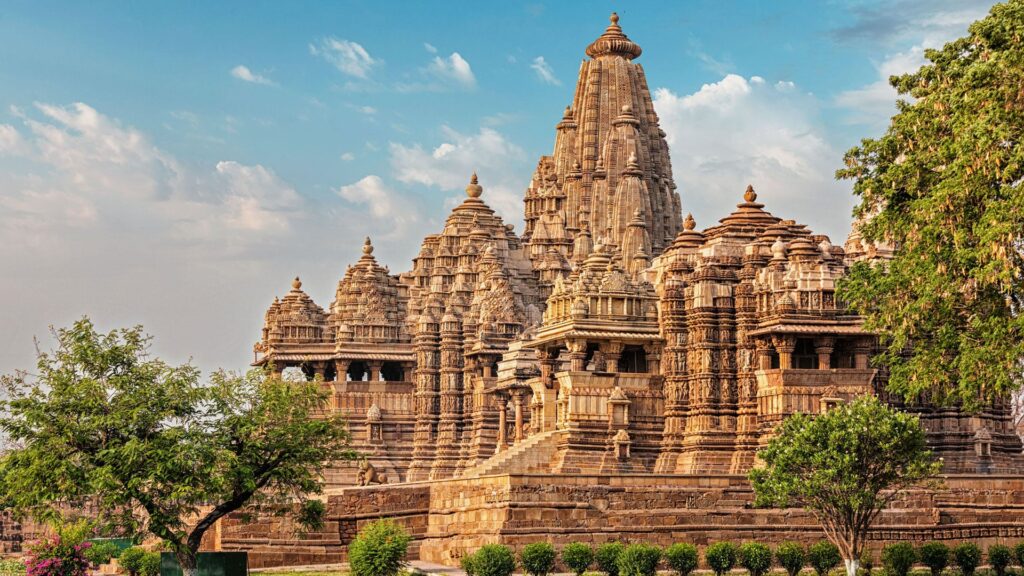
Signifying the unique North Indian architecture of the Chandella dynasty, Khajuraho is a complex of 23 temples. Built between the 9th and 10th century, these temples exemplify the Nagara style of architecture. By the 12th Century, the complex had 85 temples, of which only 23 survived till today.
Chinese pilgrim Xuanzang made the first mention of Khajuraho in his journals in 641. After the fall of the Chandela dynasty and due to the continuous onslaught of invaders, these temples suffered great destruction.
5. Konark Sun Temple- Odisha
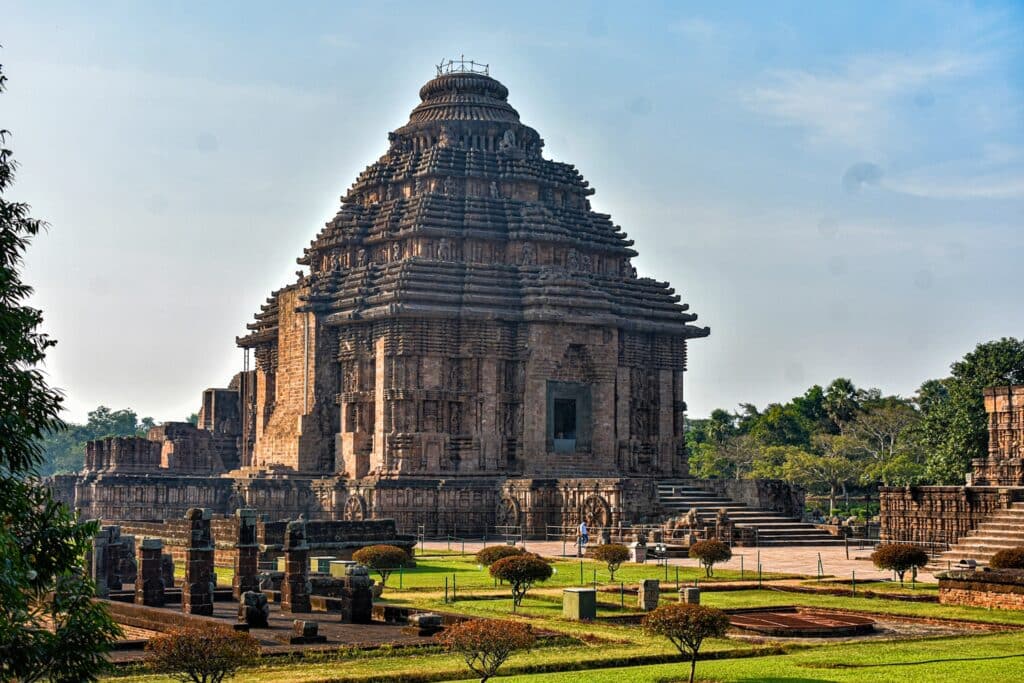
The Konark Sun Temple, located in the village of Konark, some 35 km away from Puri, Odisha, stands as a testament to the worship of the sun, a practice followed since the 19th Century BC. Built-in the 13th Century under the rulers of the Eastern Ganga dynasty, the place signifies the holy seat of Surya or the Sun.
The temple has intricate carvings of dancers, animals, musicians, etc. It also shows horses and wheels of the chariot of the Sun God. Over the years, something/someone has destroyed a large part of the temple. For example, there was a 200-foot-high Shikhara next to the chariot.
6. Nalanda- Bihar
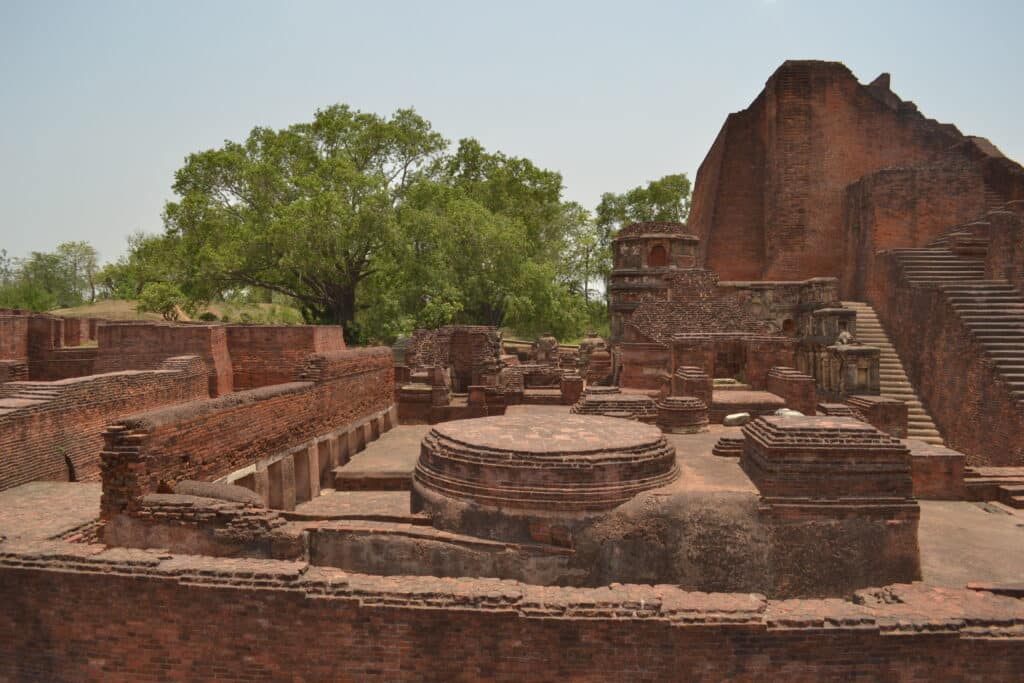
Nalanda Mahavihara, or Nalanda University, was a famous university of the ancient Magadha empire. Deemed as the first residential university in the world, it is located in Rajgir, Bihar. The university operated between the 5th Century and 12 Century. It was the symbol of the Golden Age of India.
Invaders, including Khilji, attacked a university that is now a UNESCO World Heritage Site. However, it remained in operation for centuries after that. It is the oldest of the 7 wonders of India.
7. Taj Mahal- Uttar Pradesh
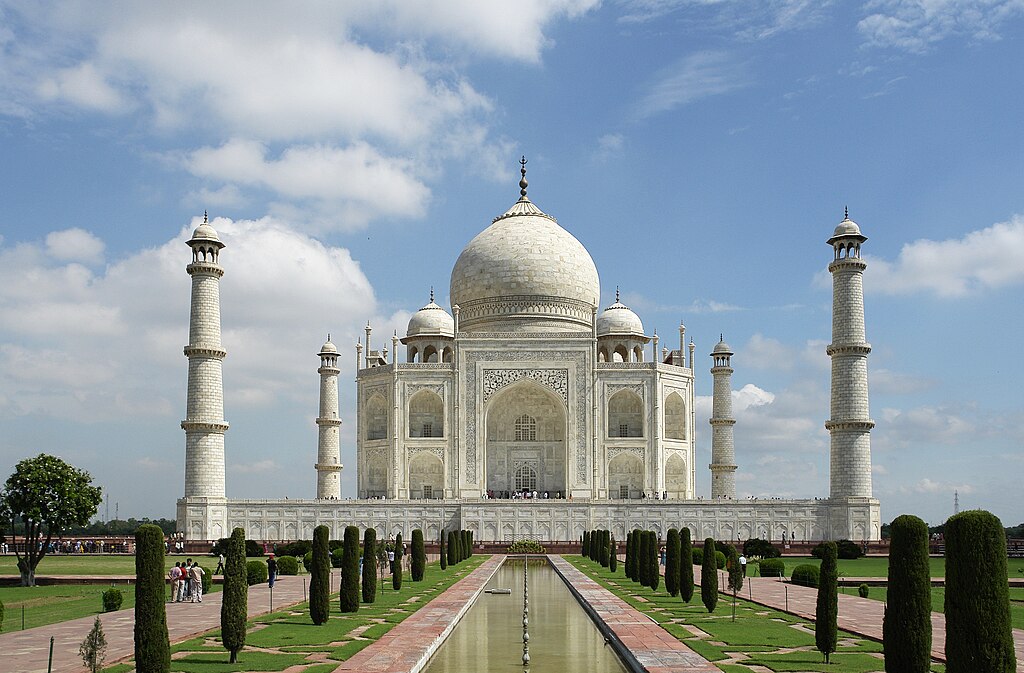
Shah Jahan, the fifth ruler of the Mughal dynasty, built the Taj Mahal, a great symbol of love in medieval India, as a mausoleum for his wife and great love, Mumtaz Mahal. The Taj Mahal is not only one of the 7 wonders of India but also one of the world’s seven wonders.
The Mughal emperor Shah Jahan built the mausoleum of white marble on the banks of Yamuna in Agra, Uttar Pradesh. It took 16 years and 20,000 artisans to complete the vast structure. Ustad Ahmad Lohri worked as the main architect of the Taj Mahal, along with various dome builders, carvers, inlayers, painters, and stone cutters.
The 7 Wonders of India: Cultural and Architectural Gems
The following seven wonders with name lists show the architectural significance of these structures.
1. Gomateshwara- Karnataka
The statue, one of the 7 wonders of India, is a marvelous feat of art with its intricate carvings and plants that cover the body. A giant stone supports the statue. The sculptor designed the statue with its arms pointing downwards and face upright in Kayotsarga facing north. The statue also portrays the Jain belief of Digambar (no clothes or nude), which signifies that a person has left earthly desires and attachments behind to attain divinity.
2. Hampi- Karnataka.
Today, the city has 1600 surviving remains built between the 14th and 16th centuries. These include temples, forts, stables, Mandapas, pillared halls, royal complexes, riverside features, and more.
These complexes boast the alluring Dravidian structure and architecture, seen in the huge pillars and massive dimensions of the structures.
Along with that, the city also boasts a multi-religious and multicultural society by the representation of Indo-Islamic architecture. The Queen’s Bath and Elephant Stables are examples of this architecture in the city. The city maintained its position as a metropolitan of the country, after which it was partially destroyed in the Battle of Talikota.
3. Harmandir Sahib Golden Temple- Punjab
The Gurudwara has openings on all four sides, which shows it is open to worshippers from every caste and creed.
However, the original temple was destroyed multiple times by Afghan invaders. Maharaja Ranjit Singh finally built it during the early 19th Century. The rebuilding was done in marble and copper, covered with a foil of gold.
4. Khajuraho- Madhya Pradesh
The temples include intricate structures with deep symbolism and expressiveness and are proof of the artistry of ancient India. The temple was long forgotten and inside an overgrown jungle until 1838, when a British engineer rediscovered it. The monuments were included in the UNESCO World Heritage List in 1986. They show the amalgamation of Hinduism and Jainism.
5. Konark Sun Temple- Odisha
The temple, which is a UNESCO World Heritage Site, signifies the Kalinga architecture. The primary elements of this style of architecture are:
- Shikhara (the crown).
- Natmandir (the dance hall).
- Janmohana (the audience hall).
- Vimana (the tower).
The image of the Sun is present at the Garbhagriha, or the sanctum sanctorum. It is said that the architecture was so accurate that the first ray of the rising sun fell on the God statue inside the Garbhagriha.
6. Nalanda- Bihar
Developed during the Gupta period, the faculty of the University were some of the greatest scholars of the time. It was the major source of sacred Sanskrit texts that Chinese travelers propagated in the 7th Century.
The university compound had various monasteries, temples, stupas, classrooms, meditation halls, and more. The main attraction was the library, called Dharma Gunj, a multistoried collection of buildings. These three buildings
7. Taj Mahal- Uttar Pradesh
Taj Mahal boasts Indo-Islamic architecture along with a beautiful symmetry and rhythmic combination. The complex includes the main gateway, mosque, garden, jawab (the building that mirrors the mosque), the mausoleum, and four minarets.
Want to see how these 7 Wonders of India look Here is the Link for the Images of the above 7 wonders of india hd images.
Importance of Preserving and Celebrating
India treasures historical sites and buildings that showcase its rich history and culture. From the palaces of Rajasthan to caves in Maharashtra and the Dravidian temples of Karnataka, India hosts a variety of cultures and architecture.
However, these sites and structures are deteriorating because of rising pollution, urbanization, and other harmful human activities. It is essential to conserve these sites so that future generations can also experience the variety of cultures that India has birthed and fostered.
Here are the reasons why it is important to preserve these cultural heritage sites:
1. To retain our culture and identity
These cultural sites are still seen as focal points of our communities. They invoke the feeling of togetherness and belonging in people’s hearts.
2. To promote tourism
Historic buildings are the focus of cultural tourism. They impact the economy of the place by attracting people to visit the ancient and cultural sites.
3. Education
These buildings are a direct mirror of our past and ancient civilizations. They teach us about the culture, beliefs, practices, architectural designs, etc., followed during those times.
The Seven Wonders of the World
The concept of the “Seven Wonders of the World” has captivated travelers and history buffs for millennia. These awe-inspiring structures represent the pinnacle of human ingenuity and artistry from various eras. Let’s explore the 7 Wonders of the World, both ancient and modern!
The Timeless Seven Wonders of the Ancient World:
- The Great Pyramid of Giza (Egypt): The only surviving wonder from the ancient list, this colossal pyramid is a testament to the organizational skills and engineering prowess of the Old Kingdom Egyptians.
Wonders Lost to Time:
- The Hanging Gardens of Babylon (Iraq): While their exact location remains a mystery, these legendary gardens were said to be a marvel of irrigated beauty.
- The Temple of Artemis at Ephesus (Turkey): Dedicated to the Greek goddess Artemis, this magnificent temple was destroyed and rebuilt several times before its final disappearance.
- The Statue of Zeus at Olympia (Greece): This colossal gold and ivory statue of Zeus, king of the Greek gods, was a marvel of craftsmanship, sadly lost to time.
- The Mausoleum at Halicarnassus (Turkey): This grand tomb built by Mausolus, a satrap of the Achaemenid Empire, was renowned for its intricate sculptures and architectural brilliance.
- The Colossus of Rhodes (Greece): A towering statue of the sun god Helios, the Colossus of Rhodes stood guard over the harbor for less than a century before being toppled by an earthquake.
- The Lighthouse of Alexandria (Egypt): This massive lighthouse, one of the tallest structures of its time, served as a beacon for sailors for centuries.
The New7Wonders of the World (2007):
- The Great Wall of China (China): Stretching for thousands of miles across rugged terrain, the Great Wall is a symbol of China’s power and a testament to human perseverance.
- The Colosseum (Italy): This awe-inspiring amphitheater in Rome was the stage for gladiatorial contests, public executions, and staged battles.
- Chichen Itza (Mexico): A sprawling Mayan city, Chichen Itza is famous for its towering pyramid, the Temple of Kukulkan, and the Great Ball Court.
- Christ the Redeemer (Brazil): This iconic statue of Jesus Christ with outstretched arms stands atop Corcovado Mountain, overlooking the vibrant city of Rio de Janeiro.
- Petra (Jordan): Carved from rose-colored sandstone cliffs, Petra, the ancient city of the Nabataeans, is an archaeological marvel.
- Machu Picchu (Peru): This mysterious Inca city perched high in the Andes Mountains remains shrouded in an air of fascination.
- The Taj Mahal (India): An exquisite mausoleum of white marble built by Mughal emperor Shah Jahan in memory of his third wife, Mumtaz Mahal, the Taj Mahal is a timeless symbol of love and devotion.
7 Wonders Of The World In India Park
The fascinating Waste to Wonder Park in New Delhi, India, features replicas of the iconic Seven Wonders of the World created from industrial and other waste materials. This innovative theme park combines environmental consciousness with awe-inspiring monuments:
1. Waste to Wonder Park: Where Scrap Becomes Art
- Waste to Wonder Park, also known as the Seven Wonders Park, is a unique attraction in New Delhi.
- The park boasts the world’s first collection of life-size Seven Wonders models, all meticulously built from scrap.
2. Monuments Represented:
- The park showcases replicas of the following iconic monuments 7 Wonders Of The World:
- Taj Mahal: The eternal symbol of love.
- Leaning Tower of Pisa: The famous tilted bell tower in Italy.
- Pyramids of Giza: Ancient Egyptian marvels.
- Colosseum of Rome: The Grand Amphitheater.
- Christ the Redeemer: The towering statue in Brazil.
- Statue of Liberty: A symbol of freedom.
- Eiffel Tower: Parisian elegance.
3. History and Purpose:
- The South Delhi Municipal Corporation (SDMC) commissioned this park as part of their Waste-To-Art Project.
- The project aimed to:
- Effectively manage waste: By transforming scrap materials into art.
- Beautify public spaces: Enhancing the city’s aesthetics.
- They completed the entire park in just 6 months.
- It was inaugurated on February 21, 2019 by the then Home Minister of India, Rajnath Singh.
4. Environmental Impact and Tourism:
- The park aligns with Swachh Bharat Abhiyan (Clean-Up India Campaign).
- It demonstrates how creativity turns waste into wealth.
- Visitors not only appreciate the wonders but also learn about recycling and sustainability.
Waste to Wonder Park beautifully marries art, environmental consciousness, and global heritage, making it a must-visit attraction for both locals and tourists. Learn more about “7 wonders of the world in India park” Here.
Final Thoughts
From the incredibly detailed Gomateshwara Statue to the grand Taj Mahal, each 7 Wonders Of India has its special tale about it’s history, beliefs, and incredible architectural skills. As we admire these amazing buildings, it is crucial to understand how vital it is to protect and honor them. By caring for these treasures, we ensure that the generations can still experience and learn from the rich culture that makes India unique.
Also Read :-
Christ the Redeemer Statue : History, Height, and Facts
Tallest Statue in the World 2023: Top 10 List
Golden Temple: History, Architectural Evolution, and Visitor Experience
Along with the 7 Wonders Of India, Read the related articles by visiting the above given Links.
Frequently Asked Questions:
Preserving these sites is crucial for maintaining India’s cultural identity, promoting tourism, and enriching education.
Shah Jahan, the fifth ruler of the Mughal Dynasty, built the Taj Mahal from 1632 to 1648.
The Gomateshwara Statue signifies the Jain practice of Digambar, along with concepts of peace, non-violence, and simple living.
Nalanda University had faced multiple attacks from neighbouring dynasties and the invader Bakhtiyar Khilj at the end of the 12th Century.
The Konark Sun Temple is considered one of the seven wonders of India. However, it is not listed among the seven wonders of the world.
Yes, The Taj Mahal makes the list of the seven wonders of the world. It’s also considered one of the seven wonders of India.
The term “Seven Wonders of India” is used to highlight seven of the most impressive and historically significant sites in India. These sites are chosen for their cultural, historical, or architectural significance, and they reflect the rich heritage of the country.
The Konark Sun Temple in Odisha earns its reputation as the wonder temple of India for its stunning architecture and intricate carvings.
Got a question on this topic?